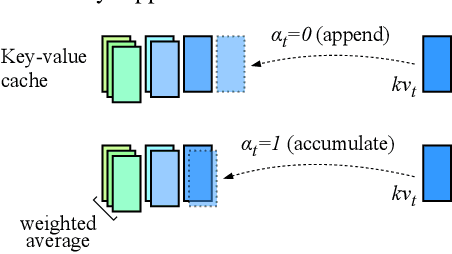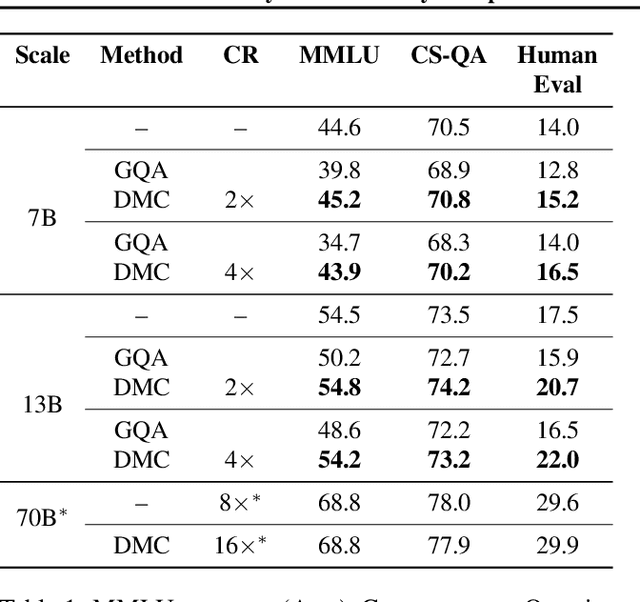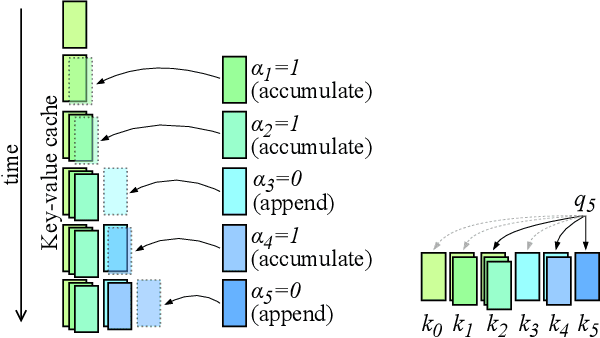Edoardo M. Ponti
The Sparse Frontier: Sparse Attention Trade-offs in Transformer LLMs
Apr 24, 2025Abstract:Sparse attention offers a promising strategy to extend long-context capabilities in Transformer LLMs, yet its viability, its efficiency-accuracy trade-offs, and systematic scaling studies remain unexplored. To address this gap, we perform a careful comparison of training-free sparse attention methods at varying model scales, sequence lengths, and sparsity levels on a diverse collection of long-sequence tasks-including novel ones that rely on natural language while remaining controllable and easy to evaluate. Based on our experiments, we report a series of key findings: 1) an isoFLOPS analysis reveals that for very long sequences, larger and highly sparse models are preferable to smaller and dense ones. 2) The level of sparsity attainable while statistically guaranteeing accuracy preservation is higher during decoding than prefilling, and correlates with model size in the former. 3) There is no clear strategy that performs best across tasks and phases, with different units of sparsification or budget adaptivity needed for different scenarios. Even moderate sparsity levels often result in significant performance degradation on at least one task, highlighting that sparse attention is not a universal solution. 4) We introduce and validate novel scaling laws specifically tailored for sparse attention, providing evidence that our findings are likely to hold true beyond our range of experiments. Through these insights, we demonstrate that sparse attention is a key tool to enhance the capabilities of Transformer LLMs for processing longer sequences, but requires careful evaluation of trade-offs for performance-sensitive applications.
Post-hoc Reward Calibration: A Case Study on Length Bias
Sep 25, 2024



Abstract:Reinforcement Learning from Human Feedback aligns the outputs of Large Language Models with human values and preferences. Central to this process is the reward model (RM), which translates human feedback into training signals for optimising LLM behaviour. However, RMs can develop biases by exploiting spurious correlations in their training data, such as favouring outputs based on length or style rather than true quality. These biases can lead to incorrect output rankings, sub-optimal model evaluations, and the amplification of undesirable behaviours in LLMs alignment. This paper addresses the challenge of correcting such biases without additional data and training, introducing the concept of Post-hoc Reward Calibration. We first propose an intuitive approach to estimate the bias term and, thus, remove it to approximate the underlying true reward. We then extend the approach to a more general and robust form with the Locally Weighted Regression. Focusing on the prevalent length bias, we validate our proposed approaches across three experimental settings, demonstrating consistent improvements: (1) a 3.11 average performance gain across 33 reward models on the RewardBench dataset; (2) enhanced alignment of RM rankings with GPT-4 evaluations and human preferences based on the AlpacaEval benchmark; and (3) improved Length-Controlled win rate of the RLHF process in multiple LLM--RM combinations. Our method is computationally efficient and generalisable to other types of bias and RMs, offering a scalable and robust solution for mitigating biases in LLM alignment. Our code and results are available at https://github.com/ZeroYuHuang/Reward-Calibration.
Cross-Lingual and Cross-Cultural Variation in Image Descriptions
Sep 25, 2024



Abstract:Do speakers of different languages talk differently about what they see? Behavioural and cognitive studies report cultural effects on perception; however, these are mostly limited in scope and hard to replicate. In this work, we conduct the first large-scale empirical study of cross-lingual variation in image descriptions. Using a multimodal dataset with 31 languages and images from diverse locations, we develop a method to accurately identify entities mentioned in captions and present in the images, then measure how they vary across languages. Our analysis reveals that pairs of languages that are geographically or genetically closer tend to mention the same entities more frequently. We also identify entity categories whose saliency is universally high (such as animate beings), low (clothing accessories) or displaying high variance across languages (landscape). In a case study, we measure the differences in a specific language pair (e.g., Japanese mentions clothing far more frequently than English). Furthermore, our method corroborates previous small-scale studies, including 1) Rosch et al. (1976)'s theory of basic-level categories, demonstrating a preference for entities that are neither too generic nor too specific, and 2) Miyamoto et al. (2006)'s hypothesis that environments afford patterns of perception, such as entity counts. Overall, our work reveals the presence of both universal and culture-specific patterns in entity mentions.
Probing the Emergence of Cross-lingual Alignment during LLM Training
Jun 19, 2024Abstract:Multilingual Large Language Models (LLMs) achieve remarkable levels of zero-shot cross-lingual transfer performance. We speculate that this is predicated on their ability to align languages without explicit supervision from parallel sentences. While representations of translationally equivalent sentences in different languages are known to be similar after convergence, however, it remains unclear how such cross-lingual alignment emerges during pre-training of LLMs. Our study leverages intrinsic probing techniques, which identify which subsets of neurons encode linguistic features, to correlate the degree of cross-lingual neuron overlap with the zero-shot cross-lingual transfer performance for a given model. In particular, we rely on checkpoints of BLOOM, a multilingual autoregressive LLM, across different training steps and model scales. We observe a high correlation between neuron overlap and downstream performance, which supports our hypothesis on the conditions leading to effective cross-lingual transfer. Interestingly, we also detect a degradation of both implicit alignment and multilingual abilities in certain phases of the pre-training process, providing new insights into the multilingual pretraining dynamics.
Spectral Editing of Activations for Large Language Model Alignment
May 15, 2024Abstract:Large language models (LLMs) often exhibit undesirable behaviours, such as generating untruthful or biased content. Editing their internal representations has been shown to be effective in mitigating such behaviours on top of the existing alignment methods. We propose a novel inference-time editing method, namely spectral editing of activations (SEA), to project the input representations into directions with maximal covariance with the positive demonstrations (e.g., truthful) while minimising covariance with the negative demonstrations (e.g., hallucinated). We also extend our method to non-linear editing using feature functions. We run extensive experiments on benchmarks concerning truthfulness and bias with six open-source LLMs of different sizes and model families. The results demonstrate the superiority of SEA in effectiveness, generalisation to similar tasks, as well as inference and data efficiency. We also show that SEA editing only has a limited negative impact on other model capabilities.
On the Independence Assumption in Neurosymbolic Learning
Apr 12, 2024Abstract:State-of-the-art neurosymbolic learning systems use probabilistic reasoning to guide neural networks towards predictions that conform to logical constraints over symbols. Many such systems assume that the probabilities of the considered symbols are conditionally independent given the input to simplify learning and reasoning. We study and criticise this assumption, highlighting how it can hinder optimisation and prevent uncertainty quantification. We prove that loss functions bias conditionally independent neural networks to become overconfident in their predictions. As a result, they are unable to represent uncertainty over multiple valid options. Furthermore, we prove that these loss functions are difficult to optimise: they are non-convex, and their minima are usually highly disconnected. Our theoretical analysis gives the foundation for replacing the conditional independence assumption and designing more expressive neurosymbolic probabilistic models.
Dynamic Memory Compression: Retrofitting LLMs for Accelerated Inference
Mar 14, 2024



Abstract:Transformers have emerged as the backbone of large language models (LLMs). However, generation remains inefficient due to the need to store in memory a cache of key-value representations for past tokens, whose size scales linearly with the input sequence length and batch size. As a solution, we propose Dynamic Memory Compression (DMC), a method for on-line key-value cache compression at inference time. Most importantly, the model learns to apply different compression rates in different heads and layers. We retrofit pre-trained LLMs such as Llama 2 (7B, 13B and 70B) into DMC Transformers, achieving up to ~3.7x throughput increase in auto-regressive inference on a NVIDIA H100 GPU. DMC is applied via continued pre-training on a negligible percentage of the original data without adding any extra parameters. We find that DMC preserves the original downstream performance with up to 4x cache compression, outperforming up-trained grouped-query attention (GQA). GQA and DMC can be even combined to obtain compounded gains. As a result DMC fits longer contexts and larger batches within any given memory budget.
Fine-tuning Large Language Models with Sequential Instructions
Mar 12, 2024Abstract:Large language models (LLMs) struggle to follow a sequence of instructions in a single query as they may ignore or misinterpret part of it. This impairs their performance in complex problems whose solution requires multiple intermediate steps, such as multilingual (translate then answer) and multimodal (caption then answer) tasks. We empirically verify this with open-source LLMs as large as LLaMA-2 70B and Mixtral-8x7B. Targeting the scarcity of sequential instructions in present-day data, we propose sequential instruction tuning, a simple yet effective strategy to automatically augment instruction tuning data and equip LLMs with the ability to execute multiple sequential instructions. After exploring interleaving instructions in existing datasets, such as Alpaca, with a wide range of intermediate tasks, we find that sequential instruction-tuned models consistently outperform the conventional instruction-tuned baselines in downstream tasks involving reasoning, multilingual, and multimodal abilities. To shed further light on our technique, we analyse how adversarial intermediate texts, unseen tasks, prompt verbalization, number of tasks, and prompt length affect SIT. We hope that this method will open new research avenues on instruction tuning for complex tasks.
Scaling Sparse Fine-Tuning to Large Language Models
Feb 02, 2024Abstract:Large Language Models (LLMs) are difficult to fully fine-tune (e.g., with instructions or human feedback) due to their sheer number of parameters. A family of parameter-efficient sparse fine-tuning methods have proven promising in terms of performance but their memory requirements increase proportionally to the size of the LLMs. In this work, we scale sparse fine-tuning to state-of-the-art LLMs like LLaMA 2 7B and 13B. We propose SpIEL, a novel sparse fine-tuning method which, for a desired density level, maintains an array of parameter indices and the deltas of these parameters relative to their pretrained values. It iterates over: (a) updating the active deltas, (b) pruning indices (based on the change of magnitude of their deltas) and (c) regrowth of indices. For regrowth, we explore two criteria based on either the accumulated gradients of a few candidate parameters or their approximate momenta estimated using the efficient SM3 optimizer. We experiment with instruction-tuning of LLMs on standard dataset mixtures, finding that SpIEL is often superior to popular parameter-efficient fine-tuning methods like LoRA (low-rank adaptation) in terms of performance and comparable in terms of run time. We additionally show that SpIEL is compatible with both quantization and efficient optimizers, to facilitate scaling to ever-larger model sizes. We release the code for SpIEL at https://github.com/AlanAnsell/peft and for the instruction-tuning experiments at https://github.com/ducdauge/sft-llm.
Are Large Language Models Temporally Grounded?
Nov 16, 2023Abstract:Are Large language models (LLMs) temporally grounded? Since LLMs cannot perceive and interact with the environment, it is impossible to answer this question directly. Instead, we provide LLMs with textual narratives and probe them with respect to their common-sense knowledge of the structure and duration of events, their ability to order events along a timeline, and self-consistency within their temporal model (e.g., temporal relations such as after and before are mutually exclusive for any pair of events). We evaluate state-of-the-art LLMs (such as LLaMA 2 and GPT-4) on three tasks reflecting these abilities. Generally, we find that LLMs lag significantly behind both human performance as well as small-scale, specialised LMs. In-context learning, instruction tuning, and chain-of-thought prompting reduce this gap only to a limited degree. Crucially, LLMs struggle the most with self-consistency, displaying incoherent behaviour in at least 27.23% of their predictions. Contrary to expectations, we also find that scaling the model size does not guarantee positive gains in performance. To explain these results, we study the sources from which LLMs may gather temporal information: we find that sentence ordering in unlabelled texts, available during pre-training, is only weakly correlated with event ordering. Moreover, public instruction tuning mixtures contain few temporal tasks. Hence, we conclude that current LLMs lack a consistent temporal model of textual narratives. Code, datasets, and LLM outputs are available at https://github.com/yfqiu-nlp/temporal-llms.
 Add to Chrome
Add to Chrome Add to Firefox
Add to Firefox Add to Edge
Add to Edge